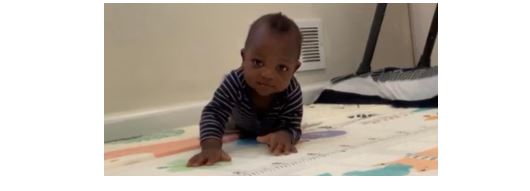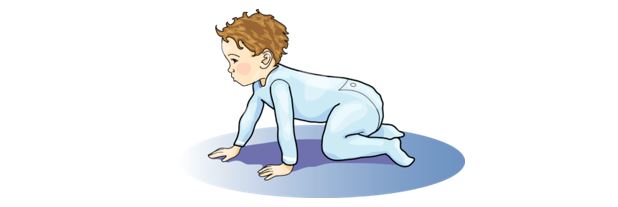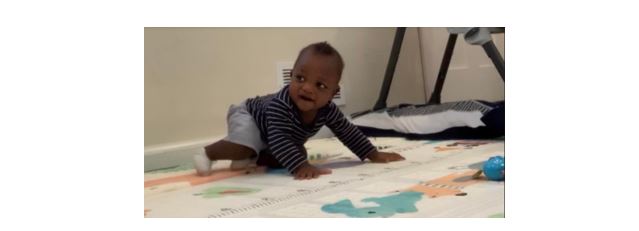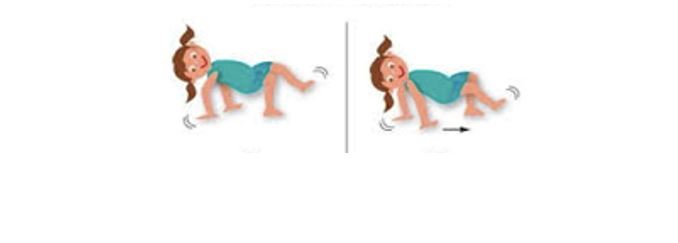
Many a times we hear questions asked about when babies begin to crawl. Well, research has it that approximately 50% of toddlers commence crawling by the 8th month while some begin a little earlier say by the 6th month or much later at the 11th month. This means babies are not programmed to a certain development pattern and age and them not crawling by your presumed age is quiet normal. It takes a lot of motivations to get your baby moving to his/her desired style, could be a belly crawl, hand and feet crawl or hand and knees crawl whichever styles it is babies just find fun in their quirky mode of locomotion. This means that amidst the motivation lays the baby’s crux decision which is very important. For instance, some babies find crawling a bit uncomfortable and prefer always being in the upright position as they commence their locomotion journey.
While motivation is a key factor and push towards their movement, we must also consider environment and space around them, freedom is paramount in each and every one’s life, and we seem to blossom more when granted immense space and freedom. Babies are no exemption as they need adequate space to be able to lay down and move freely. So when we decide to put emphasis on the toddlers’ growth development and modes of locomotion we should as well consider the variations that come with it and what to expect throughout that window period.
How do babies commence their crawling journey?
Every baby’s crawling journey begins with a tummy time, which is basically the numerous moments they spend consciously awake lying on their stomach unattended to. It is through these moments that they build muscles that aid them through self-support systems such as holding up their necks and shoulders. The built-up muscles further provide them with enough strength to try other moves such as sitting up, balancing on plank like positions, rolling over constantly and forward movements.
Do babies have prerequisite skills that aid crawling?
There is absolutely no law of order unto which a baby’s crawling is channeled through, neither do they practice the movements in a tailored order. One thing is for sure though; in their various paths they must at least master one movement before taking the plunge. In some cases the baby may as well begin crawling before perfecting the sit up milestone. So as much as they have no particular order of evolvement, all these are important growth signs that must be granted much attention and motivation.
Can you help your baby get started with crawling?
That’s an absolute fact with an affirmative response. Do this practically with much enthusiasm, literally join your baby down on the floor and be sure to maintain direct eye contact for easy communication. Encourage the baby to try moving forward; at times getting the forward propulsion may be a hindrance. In such cases provide assistance; put one hand behind the baby’s feet for resistance towards the backwards movement. The baby will eventually push against your hands and move forth. At the mention of crawling we mostly envision infants scampering around either on their tummies or knees and hands but then the prone of progression has many hats in its crown asides the pictured movements. Here is a sneak peek into various crawling styles:
The Belly Crawl

Alternatively known as the commando crawl, the belly crawl is the most commonly experienced in babies. The belly creepers normally begin their journey in between the 4th and 5th month, and hardly rise to their knee faster. It can actually end up being their only crawling method up until walking without shifting to any other classic crawl, and there is absolutely nothing abnormal about it.
The Classic Crawl

The classic crawl involves the alternation of both hands and knees throughout the movement. Certified studying calls it creeping as it relies on balancing of the bodyweight to keep the abdomen off the ground. Normally half the babies who begin on belly crawling effortlessly shift to classic crawling within a few months. However, this does not make belly crawling a prerequisite to classic crawling, some babies can actually commence on classic crawling without going through belly crawling. No matter the history, you will actually experience balancing and rocking practices on your baby before the actual crawl.
The Bear Crawl

The bear crawl is almost similar to the classic crawl but with a distinct twist. In the bear crawl the baby walks on the four limbs, but with the abdomen lifted much higher off the ground. The baby balances completely off the ground with the use both arms and legs unbent.
The Step Crawl

On some occasions we see babies crawl on one knee while generously pushing forward with the help of one hand and foot. This is what’s called step crawl; it literally fits in the meaning, as the baby has to step to push through the crawl, it is also presumed to be a mash up of classic and bear crawls.
The Crab and Leapfrog Crawls

These two are basically the opposite of the other; in the crab crawl the baby pushes instead of pulling which unintended as it is sends the baby backwards. So in such cases you will see the baby crawling backwards instead of forward. While in the leapfrog crawl the baby has to use the arm and legs to build a bridge before thrusting forward.
The Roll

Rolling is considered a crawl because it grants most babies the most comfortable means of locomotion. Also, some babies either keep switching back to rolling or constantly alternates even after advancing to other stages of crawling. More than anything, crawling depicts some form of freedom for the baby. Basically it’s the first time the child has to cognitively explore the environment and gain some form of independence. Even though study has the 9th month as the average crawling time, it’s advisable to have a positive mind towards alterations as development growth allows variation at each and every child. Also note that before a baby crawls he or she has to master a few milestones and grasping as we all know differs in speed. Be open-minded to whatever crawling style the baby settles for and offer maximum support, it will look normal in a couple of months.
Are you familiar with this crawling styles? Let us know if it is a ‘YES’ or ‘NO’
